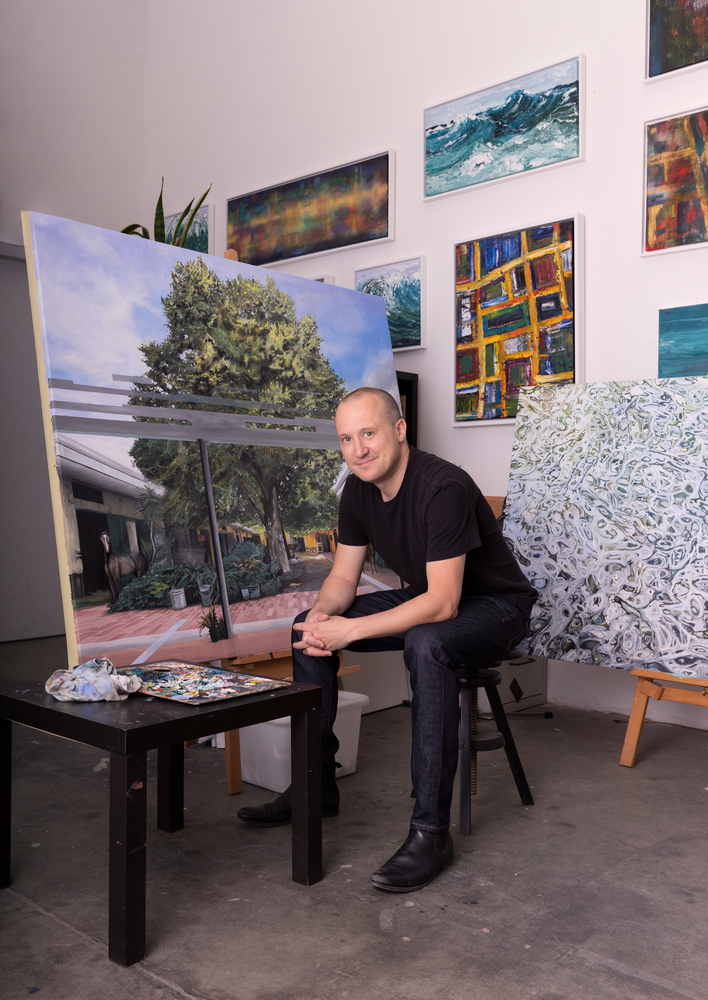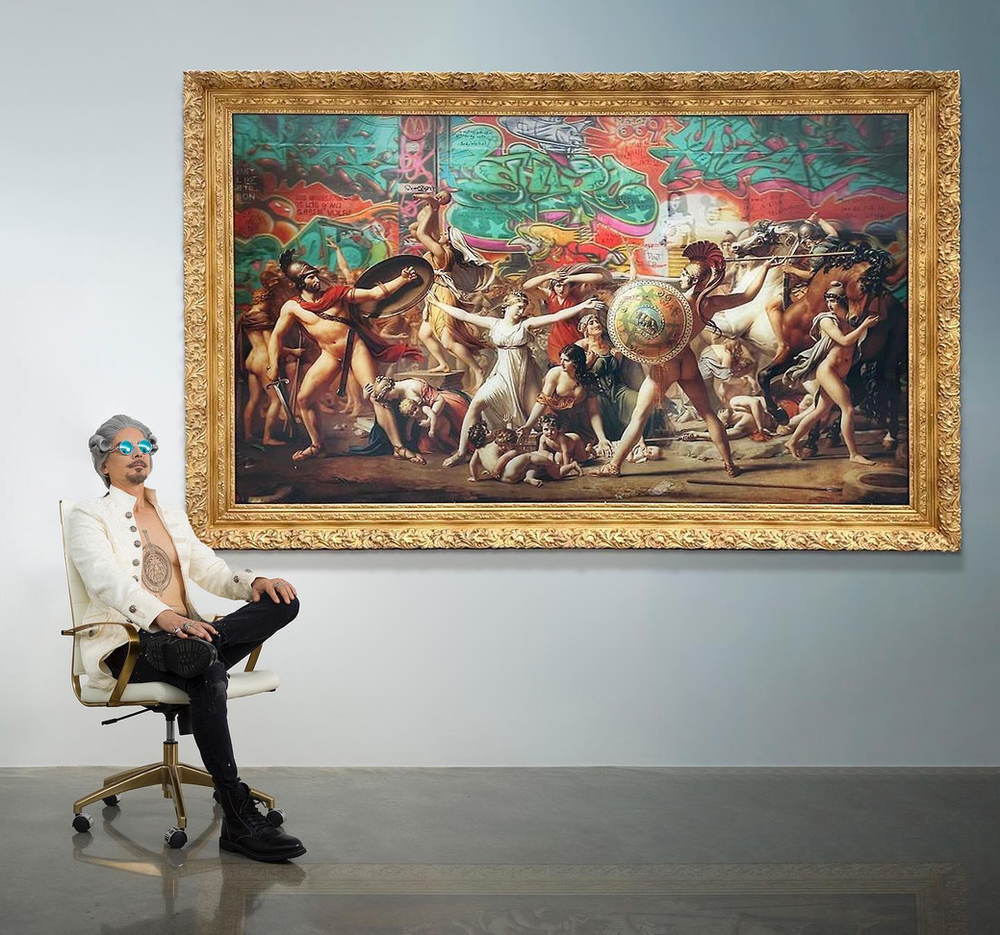Detlef “Dego” Gotzens has amassed over four decades of experience working with various materials, including glass, metal, wood, and stone. However, it is in painting where he finds himself continually drawn. The symbiosis between his stained glass and design work and the abstraction of his paintings is evident, with the colors and forms evolving from a lifetime spent engaged in restoration work on architectural projects, such as those found in churches, parliament buildings, and cultural centers.
Gotzens’ artistic career began in a stained glass studio in Cologne, where he studied glass technology and design in proximity to Bonn before immigrating to Canada and establishing his own studio. Since then, he has been actively painting and participating in restoration projects across the American continent. His desire to establish a common visual language through sculpture, painting, and stained glass has been a lifelong preoccupation, with each form offering different spaces to explore. Gotzens’ artwork is an expression of freedom, driven by intuition, while his glasswork is more calculated, planned, and organized.
Gotzens’ ability to experiment with various materials, forms, and processes imbues his art with a sense of novelty, and each painting represents a re-examination of the whole. Design and gestural elements dominate his dreamscapes, with each image representing a step in his pursuit to discover a lexicon that can be applied equally to a window, sculpture, or painting.
The artist expressed his thoughts regarding his artwork as follows:
Since childhood, I have always been captivated by the beauty of images, colors, and shapes. The world of art, especially paintings, has always evoked a sense of awe and inquisitiveness in me. As an artist, I am constantly seeking to develop a visual language that evolves with each artwork I create. This journey is an endless adventure that takes me to new and thrilling places.
I love exploring different avenues in my paintings, ranging from landscapes to abstract works and even portraits of individuals who hold significant meaning in my life. My art reflects both spontaneous expression and structured form, a true reflection of my personality.
I often draw inspiration from the same landscape view, capturing it at various times of the year and day. This pursuit of multiple paths keeps me motivated and passionate about my craft.
What was the impetus for your pursuit of art and subsequent career as an artist? Did a specific event, emotion, or experience lead you down this path?
As a child of around 7 or 8 years old, I discovered a love for drawing. I would spend hours poring over illustrations in books, copying them and experimenting with different colors and mediums. My passion for creating art only grew from there, and I was lucky enough to have a grandmother who believed in my abilities. For my birthday one year, she gifted me a wooden box set of oil paints and brushes, which only fueled my artistic drive.
Despite some initial resistance from my parents, I eventually found my calling as a stained-glass craftsman. I was fortunate enough to come across a studio in my neighborhood in Cologne that worked with some of the most talented contemporary artists of the time. This experience not only solidified my desire to pursue a career in the arts, but also opened up new opportunities for me to explore the world of glass as a medium.
Could you please elaborate on your artistic journey thus far? What artistic techniques have you experimented with and what subject matters have you explored?
Ever since I embarked on my journey as a glass artist, I’ve found that this material has become an essential part of my artistic expression, ranking equally beside painting. Although painting remains my primary focus, I also relish the challenge of creating sculptures with various materials, glass among them. In addition, I continue to produce stained glass for architectural purposes. While the physicality of paint is a vital aspect of my creative process, often dictating the direction of my paintings, regardless of the medium, working with glass demands a more technical approach, making it less impromptu compared to painting. As for subject matter, I trust my instincts, which often lead me to create pieces that are both figurative and abstract, with the two styles sometimes overlapping and influencing each other.
May I kindly inquire about three distinguishing characteristics present within your artwork that separate it from others and contribute to its unique identity?
As an artist, I hold three important principles dear. Firstly, I express my creativity through glass sculptures. Secondly, I seamlessly integrate art glass into architectural designs. And finally, as a painter, I hold both abstract and figurative styles in equal esteem.
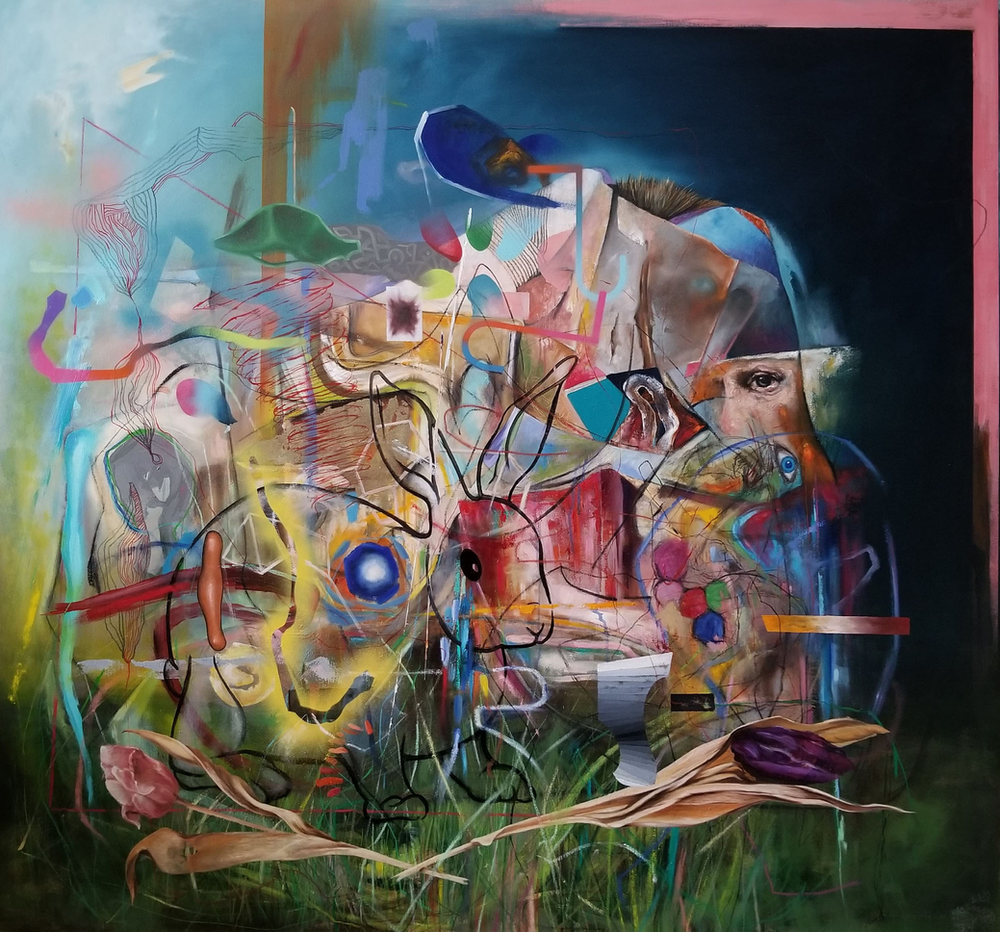
Rabbit Excavations
Mixed-Media on Canvas, 2019
142 x 152 cm
Might I respectfully inquire as to the origin of your customary inspiration?
I have been frequently asked about the source of my inspiration, and based on my personal experience, I have found that discipline plays a significant role. By committing to a regular creative practice, inspiration tends to arise naturally throughout the process. However, on rare occasions, inspiration may be sparked by external sources, such as a captivating image or the work of another artist. If such inspiration persists in my thoughts, I recognize it as a sign to incorporate it into my creative work.
What kind of emotional or experiential response do you intend to evoke through your artwork?
My approach to work is to concentrate solely on the task at hand without worrying about how it will be received by others. When I created my interpretation of Rubens’ 1611 painting “The Massacre of the Innocents,” it was a departure from my usual surprises. I was driven by a deep desire to create this piece and spent a great deal of time contemplating its narrative and how it related to both Rubens’ era and our modern world. This artwork is highly personal to me, as it reflects the current state of our society. I am convinced that it is even more pertinent today than when I first created it.My approach to work is to concentrate solely on the task at hand without worrying about how it will be received by others. When I created my interpretation of Rubens’ 1611 painting “The Massacre of the Innocents,” it was a departure from my usual surprises. I was driven by a deep desire to create this piece and spent a great deal of time contemplating its narrative and how it related to both Rubens’ era and our modern world. This artwork is highly personal to me, as it reflects the current state of our society. I am convinced that it is even more pertinent today than when I first created it.
Do you possess any particular methodologies that you favor? If so, would you be willing to elucidate upon them?
I am open to various forms of art and don’t have a specific preference. As a warm-up exercise, I typically start with charcoal drawing, which sets the tone for the rest of my day and determines what I’ll focus on next. While I have several projects in progress, some of which take longer to develop, they are scattered throughout my studio. Nevertheless, I’m always eager to create, and often switch to paper works to keep the creativity flowing. Interestingly, while working on these paper projects, I often find solutions to other works that had previously stumped me, which further propels my creativity forward.
Could you share your most significant experience related to an exhibition?
I feel incredibly fortunate this year to have had my painting “The Massacre of the Innocents” featured in my first museum exhibition at Le MUSO in Valleyfield. It’s a wonderful feeling as an artist to have your work displayed in a museum, and this opportunity is a significant accomplishment for me. The exhibit will be adapted into an educational program for both students and adults, and a documentary film about the making of my painting will be shown during its Quebec and Canada-wide exhibition tour at various museums and institutions. I’m thrilled to be able to share my work with a wider audience, and I’m also excited to announce that Le MUSO has expressed interest in showcasing my “Corona Mountains” project once it’s complete and a date has been set.
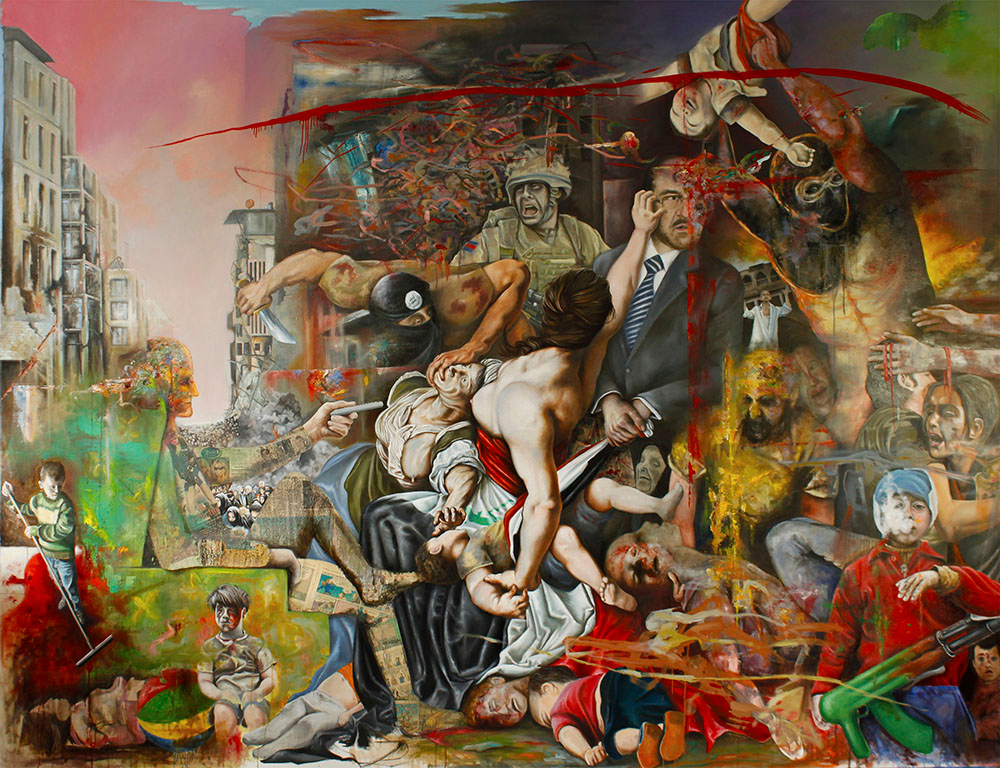
The Massacre of the Innocents
Mixed-Media on Canvas, 2018
226 x 295 cm
Would you happen to have a particular preference regarding the format or medium utilized? If so, what might be the reasoning behind such a preference?
In general, I possess the same level of comfort while working with different mediums, be it painting or sculpture. Although I relish creating on a grander scale, I cannot deny that smaller paper creations carry a distinct intimacy that makes them unique. Nevertheless, I possess the self-assurance to work with all art forms.
Do you work from home, a shared studio, or a private studio? How do you organize your production within this space?
I feel fortunate to have the opportunity to work in two distinct studios for my artistic endeavors. My primary workspace is located in Quebec, Canada, while my second studio is situated in Florida. At present, I utilize my Floridian workspace solely for painting purposes, whereas my Canadian studio caters to my sculpting needs with its industrial equipment on the premises. My artistic pursuits involve working with diverse materials, such as wood and metal, and utilizing multiple furnaces to fuse and mold glass. Yet, transporting materials poses a challenge, and I aspire to expand my Floridian studio in the future to undertake similar artistic projects there too.
Do you go to art shows or travel to meet new collectors? If so, what do you get out of these experiences?
As an artist, I’ve had the honor of showcasing my work in various galleries throughout North America and Europe, including notable locations such as England, Germany, and the Netherlands. Additionally, I was thrilled to have my pieces featured at the Karlsruhe International Art Fair in both 2020 and 2022. These exhibitions have given me the chance to connect with new collectors and enhance my visibility as an artist. More importantly, they offer valuable feedback and insight into public perception of my work, which serves as a motivating factor to continue creating and pushing my artistic boundaries.
How do you envision your artistic career evolving in the future?
I aspire to continuously evolve and broaden my lexicon as I pursue my passion for as long as I exist. Lately, I have observed a growing appreciation and broader reception of my craft. Overall, I am exceptionally devoted to my art. It is integral to my being, akin to breathing, and I cannot fathom a life without it.
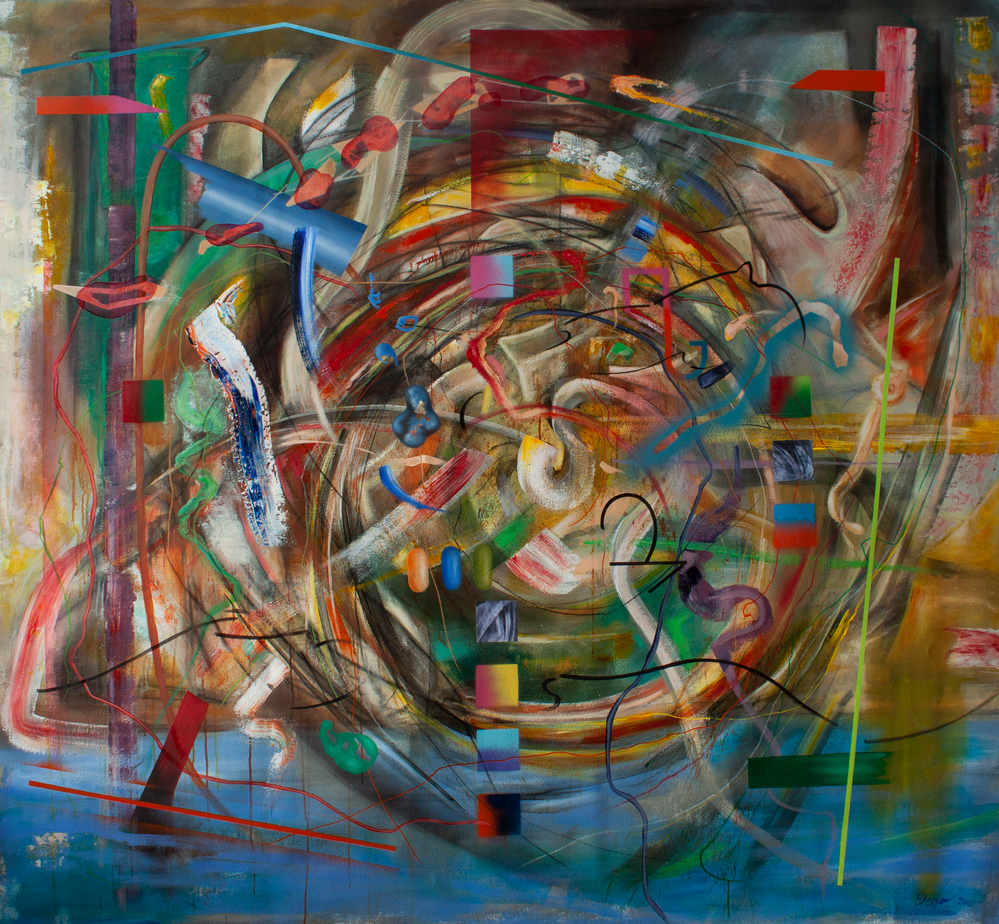
Cyclone Excavations
Mixed-Media on Canvas, 2019
196 x 180 cm
What is the theme, style, or method you incorporated into your most recent art piece?
I’m currently working on a project that began during the pandemic and has since evolved to focus on it. My project, “Corona Mountains,” consists of three large paintings measuring 77″x96″ (195×244 cm) as well as several smaller ones. In addition, I’m creating two large sculptures using metal, foam, plaster, and glass. I aim to complete all of this work by the beginning of 2024, and I’m pleased to report that the three major pieces are already finished. As is my usual practice, I’m also working on a new series of abstract works, as I always have multiple projects underway simultaneously.
Do you implement any innovative components within your work? If so, kindly share with us which ones you utilize.
As an accomplished artist, I have a deep passion for painting and sculpting. My expertise in these fields allows me to work with a wide range of materials and mediums, each of which presents its own unique challenges and opportunities for creative expression. I am constantly striving to push the boundaries of my craft, experimenting with new techniques and pushing myself to new heights of artistic achievement.
Despite my technical skill and artistic talent, I remain humble in the face of my audience. Ultimately, it is they who will decide whether my work has merit and meaning. Every new piece of art I create represents the culmination of all my previous efforts, and serves as a reminder to me to continue evolving and advancing in my pursuits. Whether working in oils, acrylics, clay, or any other medium, I am always seeking new ways to challenge myself and create something truly beautiful and unique.
If you could create a famous artwork, which one and why?
If I were asked to select a favorite masterpiece, my choice would undoubtedly be Rembrandt’s “Night Watch.” This painting has always captured my imagination with its enigmatic and ethereal lighting, revealing Rembrandt’s remarkable aptitude as an artist. I have had the privilege of visiting the Rembrandt house in Amsterdam on several occasions, and I am consistently impressed by his ability to perceive and express his visions in such commanding paintings, drawings, and prints. Despite the seeming ease with which he creates, his works radiate immense power and excellence.





